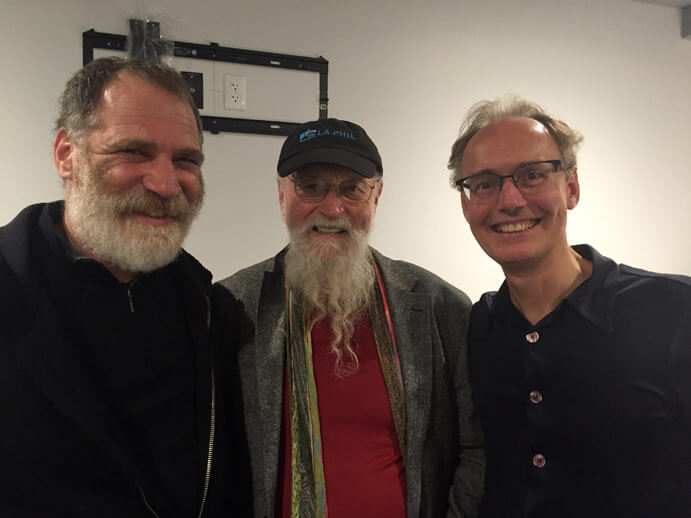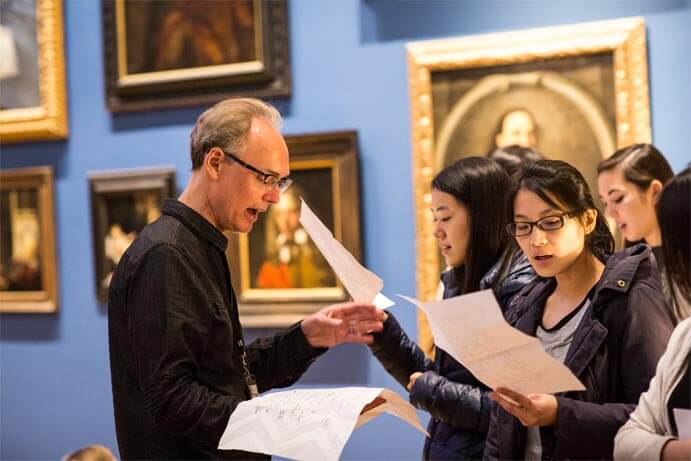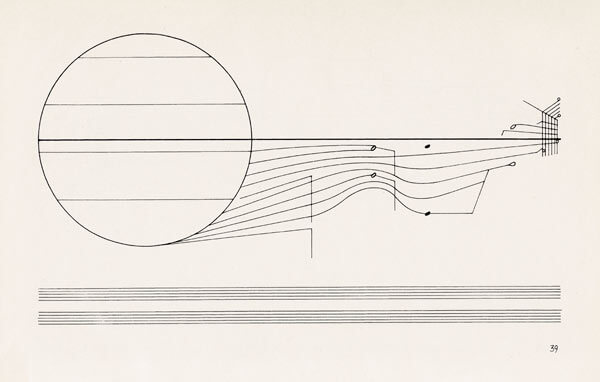Galapagos in C, a unique multimedia performance at the intersection of music, art, and architecture conceived by composer Michael Harrison and architect, artist, and educator David Gersten, was presented at the Rhode Island School of Design Museum of Art in Providence, RI, in December 2015. We spoke with Harrison to find out more.
When did you and David Gersten start collaborating?
In 2012, David created Arts Letters & Numbers, a nonprofit education, theater, film, and publishing organization, in an abandoned mill and owner’s mansion he was renovating in upstate New York. Dedicated to creating new structures and spaces for creative exchange across a wide range of disciplines, ALN has been hosting dozens of international artists every summer to do deep inquiry into the nature of their work and create an interdisciplinary multimedia performance from the questions and experiences that arise during the workshops. In the summer of 2013, David invited me to ALN as a visiting artist. I went for the weekend, but the open creative atmosphere was so special that I ended up staying for ten days and doing music for the final performance. Since then I have been a visiting artist every year, and this summer I will be the music director for a new interdisciplinary music program we are offering from July 23 to August 7.

Architect David Gersten, composer Terry Riley, and composer Michael Harrison (photo: Sandip Bhattacharjee)
A composer teaching architecture; how did that develop?
In 2014 Laura Briggs, Dean of Architecture at Rhode Island School of Design, invited me to give a lecture there. It was such a positive experience, she invited me back to teach an Architecture class called Outside the Guidelines. There is no music department at RISD, and it is highly unusual that a composer would be brought in to teach a group of architecture students. David has been teaching at RISD for the past decade, and with Laura’s encouragement we teamed up to create a new multimedia performance with the students from both our classes.
In my class we explored principles of form and structure in music that translate nicely into architecture. We learned about whole number proportions in just intonation and how, starting in the Renaissance, these were compromised to create tempered tunings. This happened in parallel to the development of perspective in art, and both concepts have dominated these arts in similarly constraining ways. My students also learned the audio software Reaper to create their own sound works which became part of our performance. I also gave them basic music training through singing Indian ragas, which developed their voices and ears so they could learn to perform a vocal version of Terry Riley’s In C. We used the text Terry created for a 2010 performance we did at Carnegie Hall with Kronos Quartet and The Young People’s Chorus of New York City. At the same time, David’s class, Galapagos Providence, was working with principles of emergent theater and preparing multimedia works and we periodically brought both classes together for a joint session.
What were the key elements of the performance?
Ultimately our two groups combined to create an interactive multimedia performance in the Grand Gallery at the RISD Museum of Art, which we called Galapagos in C, combining the music and structure of In C with David’s ongoing Galapagos Project, an archipelago of works initiated through ALN in 2015. The Galapagos Project recognizes cultural diversity as a range of ways of knowing, and proposes a new vision of education to make significant contributions towards creating a better world. The Grand Gallery was the perfect space, as David remarked about the paintings, “this room is very powerful, and it’s the exact geography that Charles Darwin turned away from when he sailed to the Galapagos and had his encounter with the natural world.”
The audience sat in the middle of the room looking out, with the performers stationed around the perimeter. We had two antiphonal choirs of eight students each, another sixteen students engaged in mime and performance art, plus guest musicians Stuart Isacoff, Eric Nathan, Molly Joyce, Sam Torres, and string players from Community MusicWorks. During the performance, we projected images, a live feed, and videos of people sketching and painting onto the vaulted ceiling. The work created a conversation with the room, drawing out the paintings into the sounds of In C using performative gestures, projections, and sound and light installations. We created duets with the figures in the paintings, listening to them. They were the audience for the performance as well as the actors.
What are your thoughts about the intersection of music and architecture?
Goethe aptly stated “Music is liquid architecture; Architecture is frozen music.” In both disciplines we create organization and structure, a fundamental difference being that in music we create structure in “time,” while as in architecture we create it in “space.” In astrophysical terms, “time” and “space” are very connected and one is meaningless without the other. Ultimately, In C is architectural in itself. It was revolutionary because it is constructed entirely from 53 short modules. Its phrases build, multiply, recombine and dissipate, and at any given moment you might have six or twelve modules overlapping, which creates a complex multidimensional experience. We were doing similar things with our performance, using layers to create form and structure, and in the process creating new ways of seeing, hearing, and knowing.
What new directions are emerging from this collaboration?
An epiphany came to me from this performance in which musicians and non-musicians created and performed new works together. It’s something that has been going on in different religious and secular traditions for millennia, but what made it feel fresh was that we were interpreting works of contemporary music and art. In C was just difficult enough that it presented a challenge, yet everyone proved capable of giving a professional level performance. Most architecture students would not expect to sing and be a musician. There was a tangible excitement in the air that was different from the experience of making music solely amongst musicians. It was incredibly satisfying when students told me that the performance was a once in a lifetime experience. I realized how important it is to give ourselves the opportunity to connect across the arts in this way. Going forward this will become a major theme at ALN as we continue developing and exploring new works of music and art that can be shared across a wide range of disciplines, and to develop new questions, thought processes and forms of knowledge.





















